Related Research Articles

Matthew Lyon was an Irish-born American printer, farmer, soldier and politician, who served as a United States representative from both Vermont and Kentucky.

Vermont has been represented in the United States House of Representatives by a single at-large congressional district since the 1930 census, when the state lost its second seat, obsoleting its 1st and 2nd congressional districts. There were once six districts in Vermont, all of which were eliminated after various censuses.

The 1934 United States Senate elections were held in the middle of Democratic President Franklin D. Roosevelt's first term. The 32 seats of Class 1 were contested in regular elections, and special elections were held to fill vacancies. During the Great Depression, voters strongly backed Roosevelt's New Deal and his allies in the Senate, with Democrats picking up a net of nine seats, giving them a supermajority. Republicans later lost three more seats due to mid-term vacancies ; however, a Democrat in Iowa died and the seat remained vacant until the next election. The Democrats entered the next election with a 70-22-2-1 majority.

The 1828–29 United States House of Representatives elections were held on various dates in various states between July 9, 1828, and October 5, 1829. Each state set its own date for its elections to the House of Representatives before the first session of the 21st United States Congress convened on December 7, 1829. Elections were held for all 213 seats, representing 24 states.

The 1826–27 United States House of Representatives elections were held on various dates in various states between July 3, 1826, and August 30, 1827. Each state set its own date for its elections to the House of Representatives before the first session of the 20th United States Congress convened on December 3, 1827. They occurred during John Quincy Adams's presidency. Elections were held for all 213 seats, representing 24 states.

The 1822–23 United States House of Representatives elections were held on various dates in various states between July 1, 1822, and August 14, 1823. Each state set its own date for its elections to the House of Representatives before the first session of the 18th United States Congress convened on December 1, 1823. They occurred during President James Monroe's second term.

The 1796–97 United States House of Representatives elections took place in the various states took place between August 12, 1796, and October 15, 1797. Each state set its own date for its elections to the House of Representatives. The size of the House increased to 106 seats after Tennessee became the 16th state to join the union. The first session of the 5th United States Congress was convened on May 15, 1797, at the proclamation of the new President of the United States, John Adams. Since Kentucky and Tennessee had not yet voted, they were unrepresented until the second session began on November 13, 1797.

The 1792–93 United States House of Representatives elections were held on various dates in various states between August 27, 1792, and September 6, 1793. Each state set its own date for its elections to the House of Representatives before the first session of the 3rd United States Congress convened on December 2, 1793. With the addition of the new state of Kentucky's representatives, and the congressional reapportionment based on the 1790 United States census, the size of the House increased to 105 seats.

The 1790–91 United States House of Representatives elections were held on various dates in various states between April 27, 1790, and October 11, 1791. Each state set its own date for its elections to the House of Representatives before or after the first session of the 2nd United States Congress convened on October 24, 1791. This was the first midterm election cycle, which took place in the middle of President George Washington's first term. The size of the House increased to 67 seats after the new state of Vermont elected its first representatives.

Peter Francis Welch is an American lawyer and politician serving since 2023 as the junior United States senator from Vermont. A member of the Democratic Party, he was the U.S. representative for Vermont's at-large congressional district from 2007 to 2023. He has been a major figure in Vermont politics for over four decades, and is only the second Democrat to be elected a senator from the state.

John Mattocks was an American Whig politician, a brigadier general in the War of 1812, U.S. Representative, and 16th governor of Vermont.

The 2010 United States House of Representatives election in Vermont was held on November 2, 2010 and determined who would represent the state of Vermont in the United States House of Representatives. Democratic Congressman Peter Welch decided to run for a third term in Congress, facing Republican Paul D. Beaudry and two independent candidates. Welch won over his three opponents by a healthy margin, which allowed him to represent Vermont in the 112th Congress.

The 1936 United States elections were held on November 3, 1936, during the Great Depression. Democratic President Franklin D. Roosevelt trounced Governor Alf Landon of Kansas in a landslide and the Democrats built on their majorities in both chambers of Congress.
A special election was held for the Indiana's 1st district after William Prince (DR-Jackson) died on September 8, 1824.

A special election was held in New York's 15th congressional district to fill a vacancy left by the death of Representative-elect William Dowse (F) on February 18, 1813, before the beginning of the 13th Congress. The election was held April 27–29, 1813.

On May 16, 1815, Representative-Elect Jonathan Williams (DR) who'd been elected for Pennsylvania's 1st district, died before the start of the 14th Congress. A special election was held on October 10 of that year to fill the vacancy left by his death.

Vermont elected its members September 7, 1824. Congressional districts were re-established in Vermont for the 1824 election. Vermont had used an at-large district 1812-1818 and 1822. A majority was required for election, which was not met in the 1st district, necessitating a second election December 6, 1824.
A special election was held in Vermont's 1st congressional district on September 6, 1808 to fill a vacancy caused by the resignation of James Witherell (DR) on May 1 of the same year, to accept a position as judge of the Supreme Court of Michigan Territory.
A special election was held in Massachusetts's 10th congressional district on September 8, 1823 to fill a vacancy created by the resignation of William Eustis (DR) prior to the start of the 18th Congress.

The 2022 Vermont gubernatorial election was held on November 8, 2022, to elect the governor of Vermont. Incumbent Republican governor Phil Scott won re-election to a fourth term in a landslide, defeating Democratic nominee Brenda Siegel.
References
- ↑ "View Election". Archived from the original on January 6, 2013.
- ↑ Source does not list party affiliation for Williams. Williams was later elected Governor of Vermont as a Whig, which suggests he may have been a Democratic-Republican in 1824, but this is not certain
- ↑ "Eighteenth Congress" (PDF). Artandhistory.house.gov. 1823. Archived from the original (PDF) on March 4, 2016. Retrieved September 24, 2016.